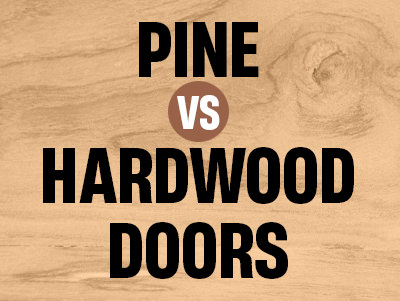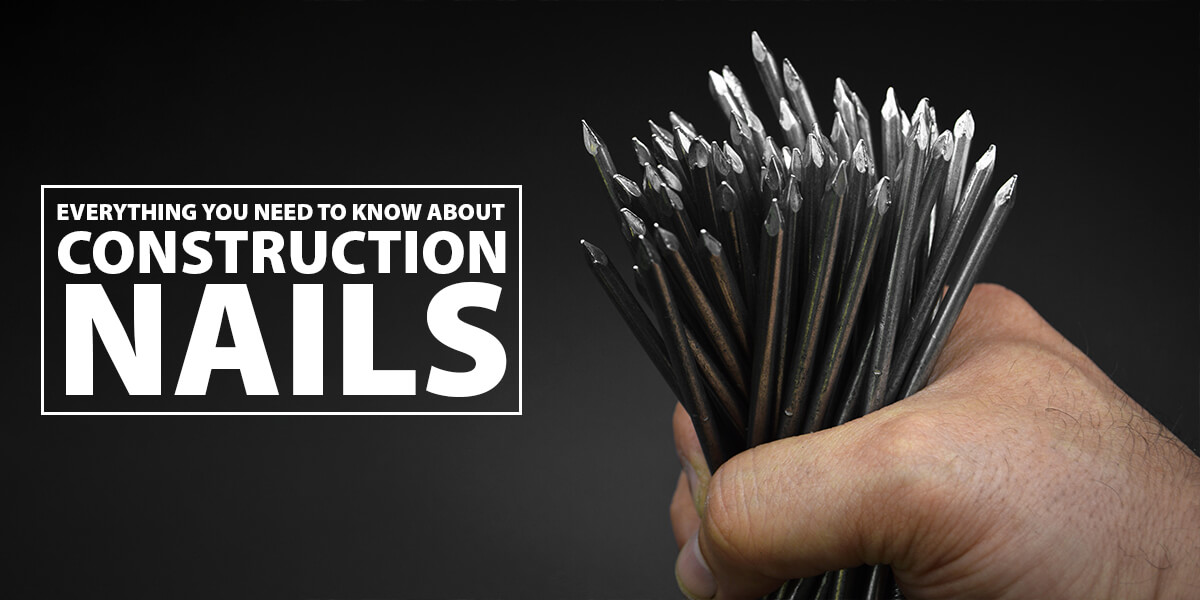
For as long as humans have been constructing anything, we've been using nails. From the handmade nails found in the Roman Empire, to the invention of the slitting mill, to cut nails in the 16th century, nails have stood the test of time.
What's even more amazing is that the nails we use today are not that different from those that were used aeons ago. Much like the wheel, the humble nail still looks a lot like it did back then.
It's safe to say that nails have a rich history, as they've laid the foundation for our modern construction techniques. Although nails haven't changed much in appearance, their fundamentals have been adapted somewhat. In today's age, we have different types of nails for different jobs.
If you thought that all nails are created equal, you'd be wrong. Take a look at the leading types of nails found in construction, learn how best to differentiate them, and the ideal use for each.
Galvanized Nails
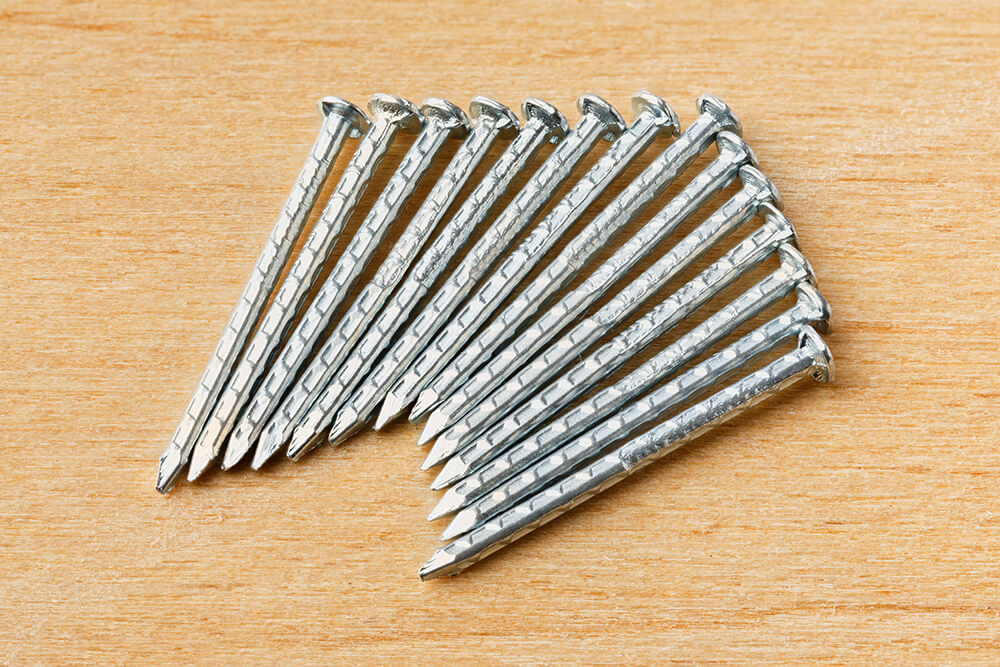
The term "galvanized" specifically refers to the coating present on a nail. The process that is used is called galvanization, in which the nails are covered in a protective coating of zinc to ward off oxidation.
Oxidation, or rust, is the enemy of any nail that is exposed to elements like rain or humidity. Galvanization itself is actually a simple act: The steel nails are either electroplated or dipped into a molten zinc mixture to give the required coating.
Zinc resists corrosion through the elements, making the galvanized nail perfect for outdoor use. You can spot a galvanized nail by its silver colour but evident lack of any shine or shimmer. Zinc is in normal circumstances a dull metal, making galvanized nails easy to spot.
Another key way to spot a galvanized nail is to feel it. There are electroplated nails, yet the dip method is more common and will leave imperfections, almost runs, on the surface.
It's important to remember that galvanizing is only treated to a nail and has no bearing on the rest of the nail properties. There are many types of galvanized nails with different head sizes, shaft shapes, and other features.
The most simple galvanized nail you will find will likely be a galvanized wire nail. If you are looking for a specific galvanized nail, be sure to know what to ask for, or explain the purpose you need it for.
Collated Nails
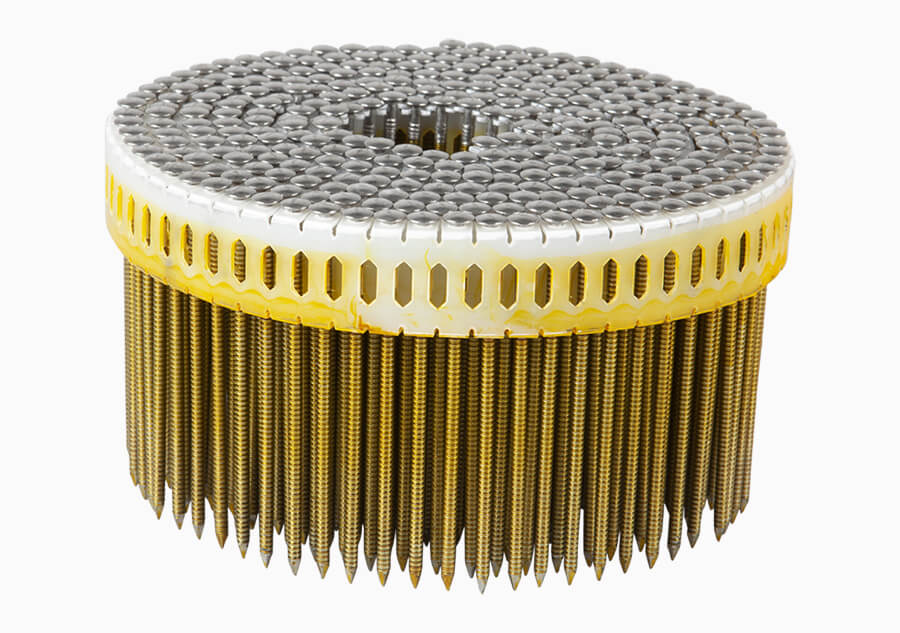
Collated nails are nails that are loaded into a strip for use with construction equipment, typically nail guns. There are several types of nail guns that use different types of nails and strips. It's, unfortunately, not a one-size-fits-all nail solution.
Paper Collation - Paper is a commonly used wrapping for framing nails, usually tilted at an angle of 30 to 34 degrees. Paper collation comes with the advantages of being inexpensive and environmentally friendly.
The disadvantages of paper as a collation material can vary depending on your equipment, the quality of the paper, and the environment in which you are working. If all the conditions for paper collation are not correct, its collation paper can tear before the nail is driven in all the way.
Torn paper strips and nails being driven in at an angle will only cause more frustration and time lost down the road.
TIP: Be sure to test your equipment with paper collation before buying in bulk.
Plastic Collation - Plastic coalition is the most common collation found. Less environmentally friendly than paper, but more convenient and, often, more cost-effective, plastic collation works by having one or two plastic strips holding the nail in place in the strip. Once the nail begins to drive in, the plastic will break, leaving a clear path for the nail to drive in.
This can leave more clean-up work and, at times, plastic stuck under the nail of the head. The number of plastic strips present will depend on your equipment, nail type, length, and angle.
TIP: It's important to find the plastic collation that works best with your equipment.
Glue Collation - While not feasible on all nails because of the heads, glue collation is incredibly effective for staples or floor cleats.
Glue collation would simply have the nails stuck together with a small amount of glue into long strips. This faces the inherent downsides of staples, in the form of less holding power. For collation, it is the most cost-effective and easiest collation to use.
TIP: If the job does not require a lot of holding power, glue collation is the best on the job.
Wire Weld - Wire weld collation would have one or two thin strips of wire attached to your nails in the strip. Wire weld lends itself to avoiding all the problems faced with paper and plastic collation.
So why does every application not use wire weld?
Surface finish and equipment.
The wire tends to get stuck under a nail's head, which can hurt the surface finish.
TIP: If your work is not in a very visible area, wire weld is potentially the perfect collation.
Different forms of collation will favour different equipment and different working conditions. Be sure to try different styles of collation and different brands with your equipment before settling on what works best for you. Besides glue collation, most forms of collation should be compatible with any type of nails that you may want to use.
Masonry Nails
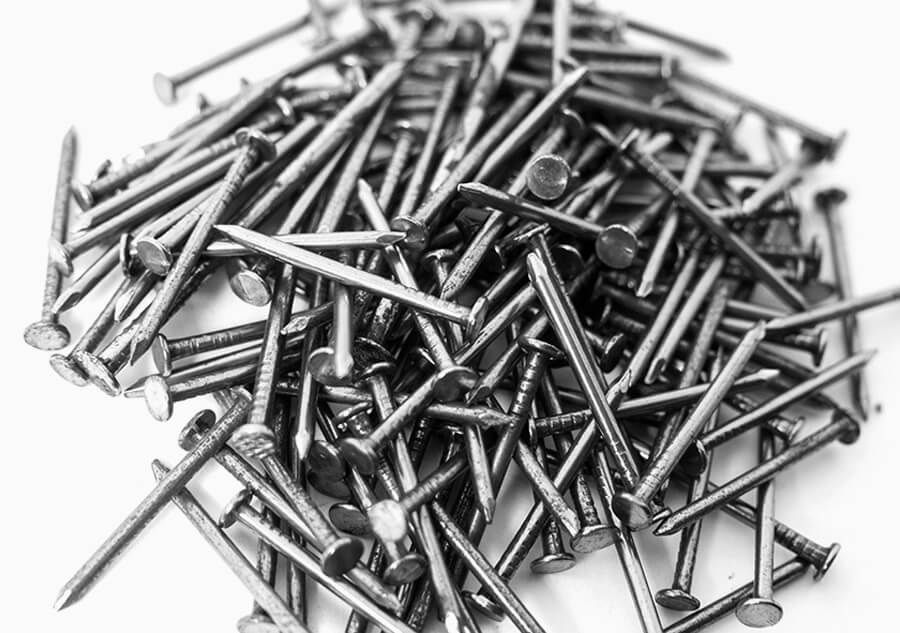
Masonry nails are nails specifically designed for use in concrete or brick.
Masonry nails are usually made from hardened steel and sometimes with a galvanized coating. It is not uncommon to find a masonry nail that is made from a hardened steel zinc alloy to allow it to retain its oxidation-proof nature. Masonry nails come in a wide range of sizes, heads, and styles, but there are 3 masonry nails to focus on.
Round - Round nails are the most common type of masonry nails to be found. Round masonry nails will excel at normal concrete work, able to burrow their own hole into the selected material. These masonry nails will also often be the cheapest of the masonry nails, while still being extremely hard and, depending on the makeup, rustproof.
TIP: To nail something down into a driveway or on an untreated floor, round masonry nails are perfect for the job.
Square - Square masonry nails are very similar in most qualities to round nail, only differentiating in shape. They will both be made from hardened steel with a rustproof zinc coating.
The main difference between square and round masonry nails is where they excel. Square masonry nails are best for nailing into brick, as they tend to put less outward force on the brick, preventing the brick from breaking in half.
While it is less likely for a brick to split when using a square masonry nail, it is still very possible and should be done with caution.
TIP: Square masonry nails are usually shaped rather than extruded like their round counterparts, so they can, at times, come with an additional cost implication.
Fluted - Fluted can be found on round or square nails. Fluted is the addition of a texture on the shaft of the nail, usually in the form of a raised section in a screw-like pattern. It's important to remember that fluted is not a screw, but only a texture for aiding in grip.
Installation of a fluted nail will be exactly like a normal nail installation. Fluted nails will excel at tasks that require higher levels of grip.
TIP: When nailing something heavy down or onto a vertical surface, fluted masonry nails will be the best nails for the job.
The shape is the biggest aspect of the masonry nail to take into consideration, but it's not all.
There are a variety of different heads which will focus on different tasks. Wide round heads for roofing applications, smaller heads for normal applications, and tiny heads for very neat applications. While the head can affect the holding power, the strength of the nail head is usually secondary to the gripping strength the nail has in the hole.
Roofing Nails
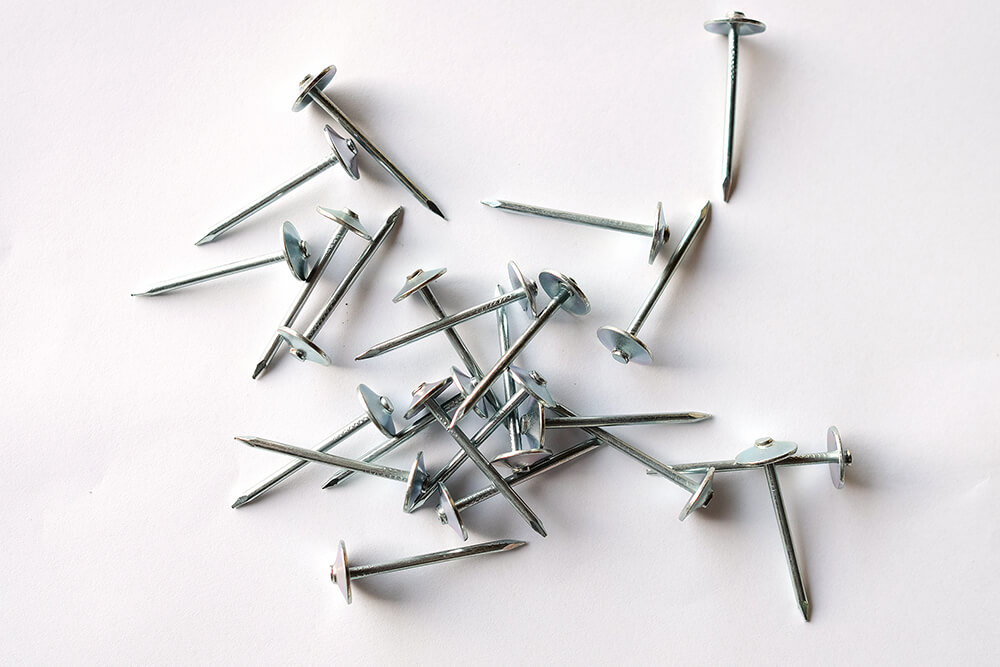
Roofing nails can have a lot of variation in size, material, and structure. However, they, all have one thing in common: the point.
The diamond-shape point present on roofing nails is specifically designed to keep the material intact. It does this by forcing small fibres to break rather than bending to split the wood. While roofing nails are not very nice for finishing looks, they excel at any application which requires a large nail to be driven into wood.
There are three main types of roofing nails to choose from.
Smooth Shank - The most basic, but also the most common due to its low price point, is the smooth shank nail. it is named that way because, as its namesake, it has a completely smooth shank.
While this provides less gripping force than other shank types, in places where grip force is not as needed, a smooth shank is perfect for the job. A smooth shank can also be ideal in applications where the nails are only temporary and intended to be removed again.
Ring Shank - Similar to fluted masonry nails, a ring shank has textured or raised rings on the shaft of the nail. These rings provide more gripping force to the nail. A ring shank is more expensive than a smooth shank counterpart. With the extra gripping force supplied by a ring shank, it becomes necessary for use in a lot of roofing applications.
Square cap - Square cap roofing nails can have a smooth or ring shank. The defining feature of the square cap nail is its large, flat head. This makes square cap nails ideal for nailing down felt underlayment but much less useful in the traditional roofing nail sense. Square cap nails are made for a very specific use case and are not to be used on any project.
Roofing nails come in a variety of different materials:
Steel - Stainless steel or galvanized steel are the most commonly used nails in roofing, as they are strong and resistant to corrosion. Steel nails are widely considered to be the best material for roof work, as they are strong and reliable.
Copper nails - Nails made from copper and brass are more common in very wet climates. Copper/brass is extremely resilient to corrosion from salt or damp conditions. These nails are generally reserved for extremely wet climates, as they are not as strong as steel nails.
Aluminium nails - Aluminium nails are more prone to corrosion than stainless steel or copper nails, while not having any additional strength over copper either.
The main reason you may want to use an aluminum nail is that certain woods could have a negative reaction to the zinc coating on galvanized steel nails. Aluminum nails do serve a very important function where steel or copper cannot be used, but they are best reserved for those instances only.
Panel Pins
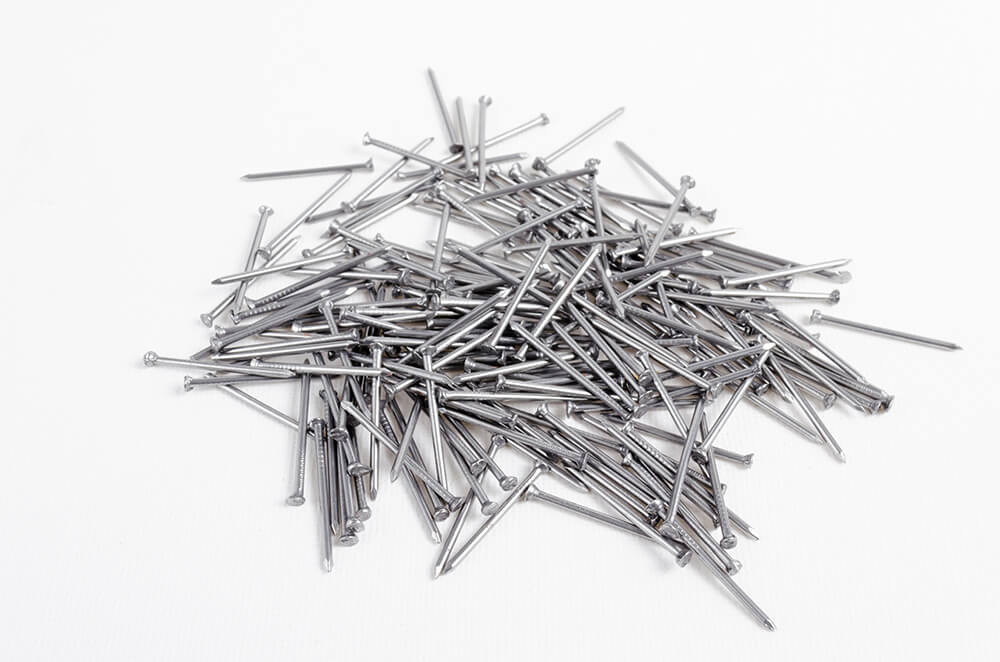
Panel pins are smaller, fine-gauge nails used for fine or delicate woodworking jobs. Attaching moulding or a veneer is the perfect job for panel pins as they do not hold much strength but are extremely neat.
One of the main advantages of panel pins lies in the size of the head. When driven flush with the wood, the panel pin becomes very difficult to spot, allowing for neat joint work.
When driving in a panel pin, it is common practice to use a punch to drive the head below the surface of the wood. This allows more gripping strength and the ability to neatly seal over the nail.
Panel pin's main drawback is not the gripping force, but the sheering force. With the small gauge, panel pins are weak and prone to breaking if put under too much stress. They are great for smaller applications, but cannot be used where strength is needed.
Double-headed Nails
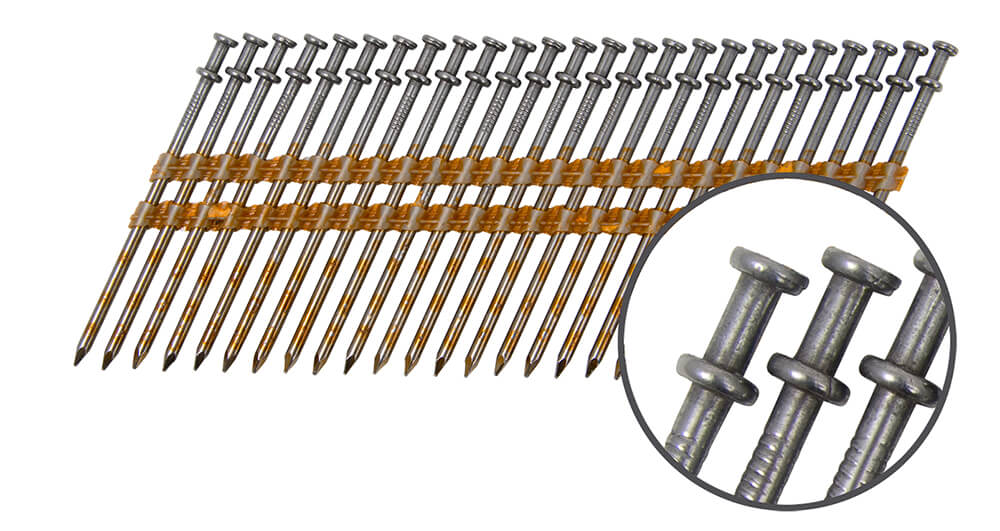
The double-headed nail or duplex nail is commonly found in stainless steel with a similar configuration to a ring shank nail, except with a secondary large head where the rings would normally be. Essentially, a larger ring lower than the head is used as a stop for the nail's depth.
It may seem counterintuitive to have a nail that is not meant to be driven all the way, but this makes a double-headed nail ideal for temporary structures. The strength of the double-headed nail is the incredible ease of removal. For temporary structures like scaffolding or bracing, a double-headed nail will be the best bet.
When purchasing a double-headed nail, it is usually advised to go for stainless steel as opposed to aluminum, as the aluminum can be weak when bending for removal.
Drywall nails
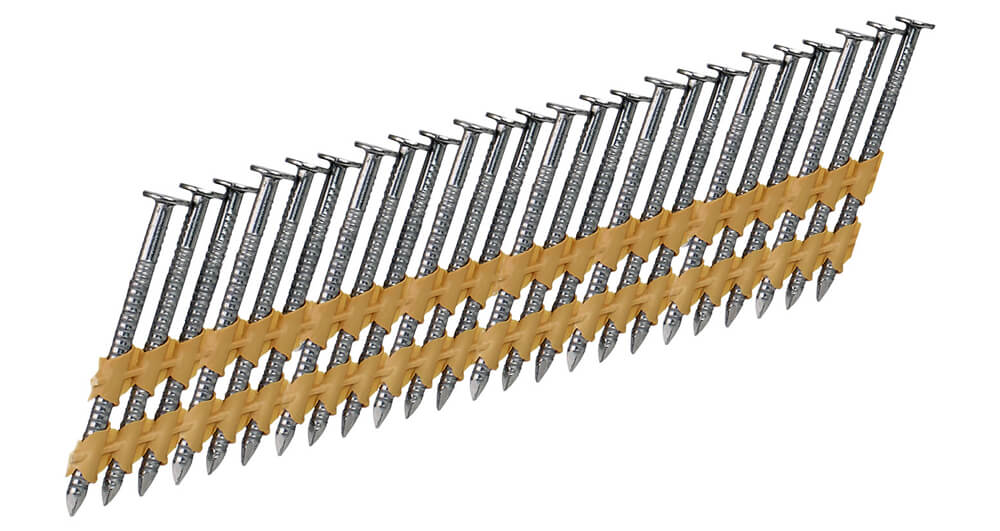
Drywall nails are similar to ring shank nails as they have rings down the shaft. Where ring shank will only have a section of textured rings, drywall nails will have rings all the way down the shaft. Drywall nails are typically used only for hanging drywall, as the ring texture lends itself to grip on the drywall well.
These nails are much quicker to install and cheaper than any drywall screw, but they do come with some limitations. Over time, with weight, especially from a ceiling, drywall nails will work themselves loose with gravity. It may not fall out, but a nail head popping out from your drywall can be an unpleasant look. For ceilings, drywall screws and generally recommended. For walls and upright sections, drywall nails will do the job perfectly.
Another key difference between a drywall nail and a traditional nail is the head. Drywall nails have a cupped head, allowing them to recess below the surface of the drywall. The cupped head allows easy and neat finishing, no matter the drywall application.
Cut Nail
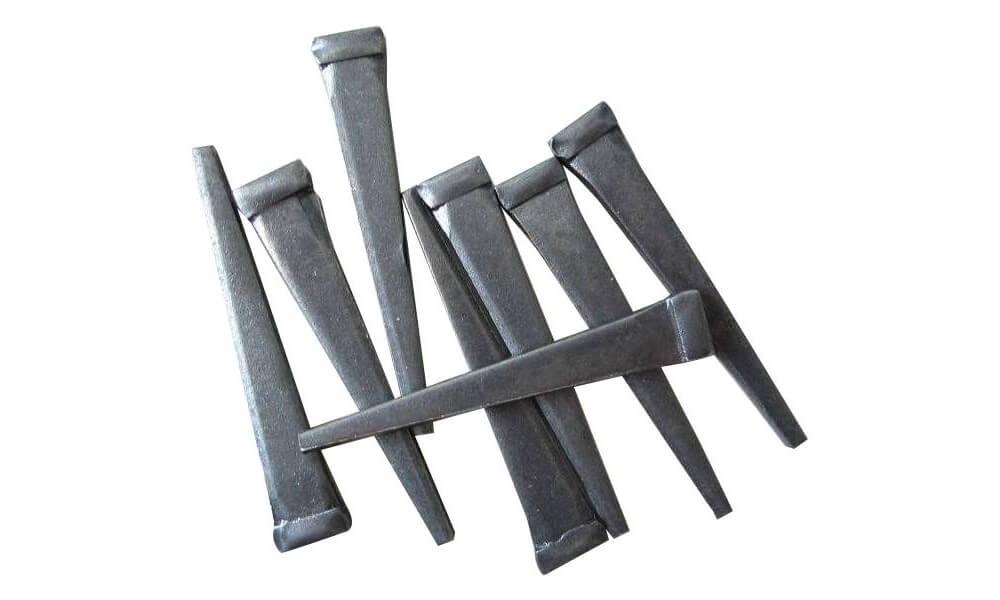
Cut nails have almost died in the current construction industry, and for good reason too. Cut nails are expensive and inefficient at gripping wood when compared to modern purpose-designed nails. These nails are only produced by a handful of people today as demand is so low but cut nails do have some advantages left.
In the right scene, a wooden floor or a classic wooden fence with cut nails looks great. A classic 1700s pre-industrial age look gives any wooden furniture or trimming a classic look and feel. For the majority of the construction and DIY industry, cut nails are not viable, as the price to performance is just not good enough.
If you find yourself doing some classic wooden flooring, a few cut nails may really bring out the classic look of your project.
Finishing Nails
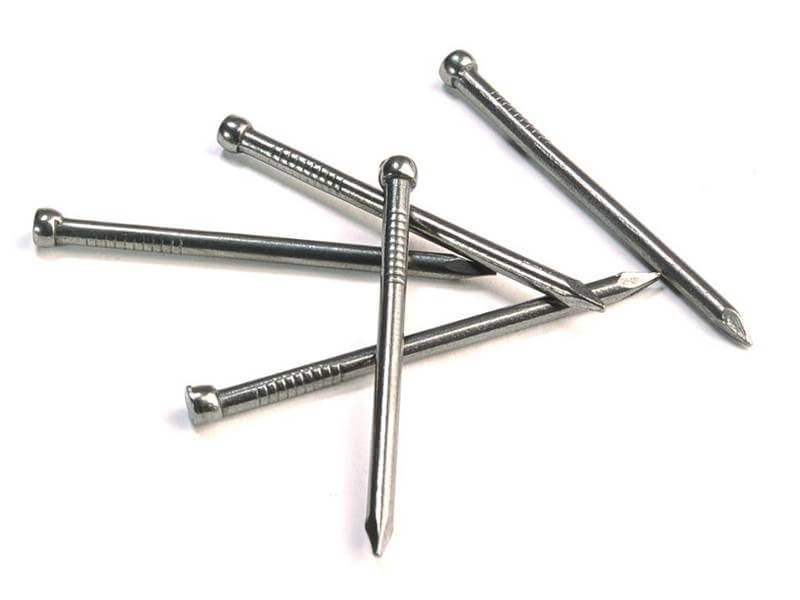
Finishing nails are similar to panel pins, only generally being thicker in diameter for use cases where more grip is needed. These nails come in a few different materials; as with any other nails, stainless steel tends to be the best.
Finishing nails are best suited for jobs like skirting, panelling, and cabinet work. Able to be sunken below the surface, finishing nails are great for non-visible work but will retain extra gripping force over other smaller pin nails. A nail set will be required to make full use of finishing nails, as when driving below the surface, there stands a good chance of surface damage. Finishing nails are the most common nails used for small-scale and DIY wood projects.
Now you've got all the information you need, it's safe to say you'll nail that next DIY or construction project.
Related Articles
Category
Doors & WindowsPosted On
13th January 2025
